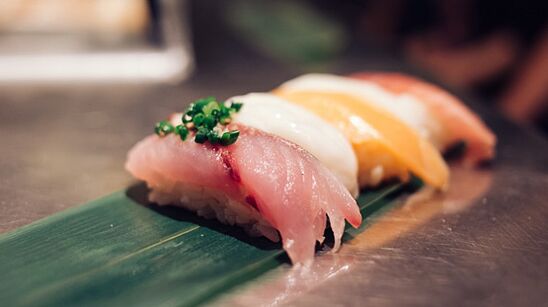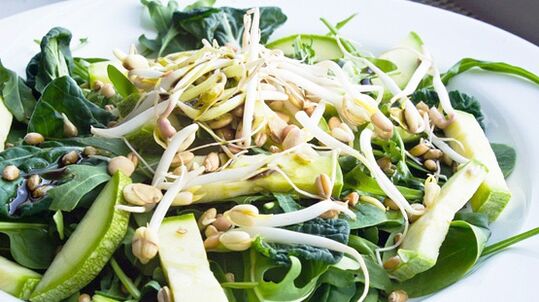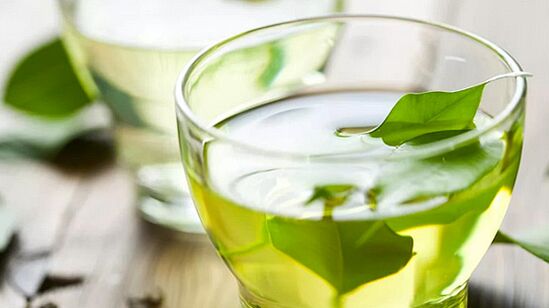
Let's say right away. Most of the "Japanese" diets on the Internet have nothing to do with Asian cuisine or the diet discussed below.. As a rule, this pseudo-Japanese dietsThey recommend eating boiled cabbage, one or two eggs a day, and 100 grams of "bird-like" portions of meat or fish, reducing the number of meals to three, and living in this mode for up to 2 weeks. Do not! Such a poor diet is not suitable for an active person.
Why is the Japanese theme and all the herbs under it so popular?
The country of the rising sun will always be attractive and incomprehensible to Europeans. Perhaps this is because Japan has long been a closed state to Western civilization. In our traditional view, what are they, the Japanese? They are technological, but they believe in spirits; conservative but invented the "Ganguro" style; stop, but capable of wild division; Even in a small class, life is valued, but historically elevated suicide is elevated to an honorable ritual. The people of the island presented the world with the most beautiful engravings and Pokemon. Also, they are thin and live longer. Why?
You can talk about genetics and physiology, or you can answer: what we eat.
The article is based on Eliza Tanaka's book The Japanese Diet.
Traditional components of Japanese cuisine
I was lying in the shade
My rice pushes me
Mountain stream.
Rice
For the Japanese, rice is "the beginning of everything" like bread for us. It is a useful source of carbohydrates that do not containgluten free. People in Japan eat all kinds of rice, but they like to eat brown rice cooked in sesame oil.
Fish and seafood

Fish dishes are the second largest source of food in the daily diet of the population of the Orient. The protein structures of fish meat are complete, easily digestible and contain essential human amino acids. But the Japanese do not eat smoked or salted fish - only fresh sea or fresh water. The fat in fish dissolves and prevents the formation of disgusting cellulite on your hips, but provides the body with unsaturated fatty acids.
Algae
Seaweed (aka kelp, brown algae) is widely used in Japanese cuisine: it is added to rice, fish dishes or soy dishes. Laminaria is good for preventing thyroid disease, atherosclerosis and heart attacks, and is rich in iodine, minerals and macronutrients. Residents of the Japanese islands also use dried kelp instead of common salt.
Vegetables and legumes
True Japanese cuisine is impossible without vegetables. These are, of course, cabbage, radishes, garlic, green onions, cucumbers and tomatoes, eggplant, carrots, peppers, beans, asparagus, spinach, celery and all kinds of salads.
Buds and branches

Valuable sources of plants, because the plants are eaten "alive" - in other words, their benefits do not die with heat treatment. In addition, germinated grain is more useful than "sleeping" grain, because then all life processes are activated.
Council: You can buy seedlings in any large hypermarket or grow your own grain on your windowsill. Take 2 tablespoons of seeds or grains, place them in a bowl and fill with water at room temperature so that the liquid level is 6 cm above the surface of the grains. Cover the container with gauze and leave for 7-12 hours. Then drain the water and shake the beans well. The plants should be stored in the dark, they can be replaced with vegetables for salads, soups and side dishes. Just don’t make big stocks for future use.
Fruits and berries
For us, instead of traditional pastries and confectionery, Asians eat fruits as a dessert. At the same time it is necessary to eat fruits on time, in other words, to eat strawberries in winter.
Spices and condiments
Curry, black, red and cayenne pepper, anise, turmeric, garlic, horseradish, dill, ginger (fresh and salted), basil, mustard, cilantro, cinnamon are added to many dishes. But the bay leaf, on the contrary, was not used. Salt is also not highly valued, and instead used dry kelp powder (as we have already mentioned), soy sauce or sesame oil.
Green tea

Tea is believed to have many medicinal properties: it strengthens teeth, calms the mind, cures heart disease, detoxifies toxins and promotes longevity. The basic principle of drinking Japanese tea is: "Drink - share, refilled - drink. "The second cup of tea is the most valuable (especially if you brew the tea with a cup).
Council: To make the tea fragrant and as useful as possible, first rinse the kettle with boiling water and close the lid to heat it. Then rinse the tea leaves in warm water and put 1-2 teaspoons in a teapot. For a cup of tea, fill the tea leaves with water that is not hot at 80 ° C. First, fill a third of the kettle with water and let it stand for 3-5 minutes. Then, add up to half and leave again, but for 1 minute. Then add as much water as you need to make tea and infuse for a minute. The tea is ready.
Tofu
This is a pea cheese that provides complete protein for Asian vegetarians: 240 g of tofu contains as much protein as two chicken eggs. 100 g of tofu is 20% richer in calcium than 100 g of cow's milk. Soy absorbs 95% of protein, which is rich in lysine, calcium, iron, vitamins B, E and K. Tofu is an excellent dietary product and despite all its high nutritional value, bean curd is very low in calories. It is smallcarbohydratesand no cholesterol. Unlike acidic meat, tofu is alkaline. Nutritionists, on the other hand, say that an alkaline environment is more beneficial than an acidic environment, and recommend eating at least 25 grams of soy protein a day.
Benefits of the Japanese diet
Many people can't stand the diet because the taste of the diet is so limited that sometimes it limits what we eat. Enjoying the taste of food is a joy that will not go away for a long time and will not harm the well-being and mood. The real Japanese diet consists of delicious foods made from healthy and low-calorie foods.
Disadvantages of the Japanese diet
The diet assumes that you need to master some recipes of Asian cuisine, and also requires certain adaptations. This diet is technically more complex than many other foods, in that you take one or two meals and eat them for a while or until you get sick.
Learning Japanese cooking techniques can be seen as another skill in your arsenal, and being able to sit on a string is amazing, and you can be proud of that.
So you will need a kitchen inventory:
- Wok, or wok for quick frying or baking;
- non-stick coated containers;
- Double pot (you can put a metal binoculars in a pan instead of a double pot);
- Combine, mixer;
- Wooden utensils made of beech, cherry or maple to mix cooked food: wood does not absorb odors and lasts a long time;
- Wooden skewers or candles.
You will need it for cooking:
- different types of rice;
- noodles;
- mushrooms;
- Spices and herbs;
- Sauces: soy, teriyaki, fish, oysters.
Japanese products should not be a big problem for you, now you can buy them in any hypermarket or easily replace them with some of our ingredients. Don't be afraid to experiment.
Japanese diet: basic principles

The Japanese diet menu includes many soups and vegetable dishes.. This is a great strategy for weight loss because such foods are low in calories and good for digestion. And the vegetable dietary fiber in vegetables provides the necessary satiety to your stomach, so you do not feel hungry.
The number of calories on the menuThe drinks are shown without the addition of sugar or sour cream. So don't forget to add 1 teaspoon of 16 kcal to your daily intake. a tablespoon of sugar and 36 kcal of sour cream (if you use them). In other words - sweet coffee - reduces the size of the main portion of food. It is recommended to use soy instead of cow's milk.
The optimal number of calories consumed per day should be in the range of 1200-1400 kcal (for women). This number of calories is enough for the body to survive at rest, before meals and at an average ambient temperature. On the one hand, reducing calories to 1200-1400 does not cause pathological changes in metabolism, on the other hand, it allows you to spend the whole day (without feeling disturbed), fitness classes provide your body with energy by burning. own oil reserves.
The dangers of a diet that reduces calories to less than 1, 200:
- With rapid weight loss, you will quickly lose the pounds or more you lost;
- Weight loss will be followed by fatigue and constant tiredness, as well as loss of muscle mass.
- The more muscle you lose, the slower your metabolism will be, making it harder to lose weight or maintain weight.
Basic rules of the Japanese diet
- Do not try to artificially speed up the weight loss process, reduce the number of calories (we wrote about the consequences above). You need to lose no more than 1 kg per week.
- Be in the range of 1200-1400 calories per day. Be sure to supplement with vitamins and minerals.
- Maintain energy balancebetween the energy received and the energy consumed. We get calories from food, we spend fitness. This imbalance, unfortunately, leads to overweight.
- The key to weight loss in the Japanese diet is a variety of foodsand the transition from small portions, fatty meat foods to a healthy diet based on fruits, vegetables and seafood.
Asian nutritionists have developed a nutrition pyramid that can be used as a guide in planning a diet and the ratio of certain foods in it.
Tips for effective weight loss on the Japanese diet
- Monitor your physical activity and diet (calorie counting). This makes it easier to see progress;
- Strict adherence to the selected meal plan and portion size;
- Don't think food is "good" or "bad", enjoy the process of eating;
- If you allow yourself to eat high-calorie foods on any given day, cut back on the calories in your diet the next day;
- Do aerobics.
You can initially lose more than one kilogram per week. This is due to loss of fluid in the body. Weight loss will be slower, but don't despair - it's a completely normal weight loss process.
Sample Japanese diet menu for 14 days (table)
| The day | Menu of the day | |||
| Breakfast | Lunch | Snack | Lunch (dinner) | |
| one |
|
|
Apple. Calories: 80. |
|
| Total daily caloric intake1428 kcal | ||||
| 2 |
|
|
1 cup unsweetened coffee. Calories: 5. |
|
| Total daily caloric intake1386 kcal | ||||
| 3 |
|
|
1 cup soy milk. Calories: 150. |
|
| Total daily caloric intake1334 kcal | ||||
| four |
|
|
Calories: 30. |
|
| Total daily caloric intake1424 kcal | ||||
| 5 |
|
|
1 orange (fruit salad) Calories: 141. |
|
| Total daily caloric intake1443 kcal | ||||
| 6 |
|
|
|
|
| Total daily caloric intake1433 kcal | ||||
| 7 |
|
|
1 cup soy milk. Calories: 150. |
|
| Total daily caloric intake1392 kcal | ||||
| eight |
|
|
1 glass of vegetable juice. Calories: about 70. |
Calories: 576. |
| Total daily caloric intake1424 kcal | ||||
| 9 |
|
|
120 g of fruit yogurt. Calories: 60. |
|
| Total daily caloric intake1440 kcal | ||||
| ten |
|
|
10 young carrots. Calories: 38. |
|
| Total daily caloric intake1303 kcal | ||||
| eleven |
|
|
|
|
| Total daily caloric intake1290 kcal | ||||
| 12 |
|
|
|
|
| Total daily caloric intake1441 kcal | ||||
| 13 |
|
|
1 cup cherries. Calories: 31. |
|
| Total daily caloric intake1430 kcal | ||||
| fourteen |
|
|
10 young carrots. Calories: 38. |
|
| Total daily caloric intake1272 kcal |
If you're a little scared of food names (you've never cooked it) - don't worry, there are recipes for all the dishes that appear in the Japanese diet.
We keep the results
You should abandon the diet and gradually increase the number of calories to a level that allows you to maintain your weight without change. Add 100 calories to your diet for 14 days. At the same time, you need to control your weight. If the scales show weight loss, add another 100 calories in the next 2 weeks and check the scales again. Once you have gained weight, you decide for yourself how many calories you need to maintain a healthy weight.
100 calories are:
- pork, beef - 80 g;
- 1 boiled chicken breast;
- 150 g of fish;
- one egg or 2 yolks, or 5-6 proteins;
- a glass of milk;
- yogurt - 125 g;
- a glass of kefir;
- a small slice of bread;
- peas - 25 g (3–4 tablespoons);
- fresh cabbage - 1 kg;
- fresh cucumbers - 750 g;
- 3-4 large carrots;
- the bottom of a large potato;
- tomatoes 590 g;
- 625 g of sauerkraut;
- bananas - less than 1 piece;
- apricots - 210 g;
- fresh strawberries - 325 g;
- 1 large apple;
- 1 large orange;
- 2 kiwis;
- peaches - 250 g;
- 4 tangerines;
- prunes - 200 g;
- 1 grapefruit;
- watermelon - 285 g;
- 1 large pear;
- melon - 190 g;
- 15-20 large grapes;
- various nuts (2 tablespoons) - 15 g;
- noodles - a portion the size of a palm;
- muesli, oats - 1/3 cup;
- porridge in water - 5–6 tablespoons. l. per serving.
We hope you succeed! Good luck!

















































































